|

|
RS 2000 Series Granulators:
The RS 2000 Series granulators can best be summarized as a medium-duty version mid-sized granulators. Most common feedback existing owners comment on is the build quality and heavy duty nature of this series compared to other brands in the same size range.
Common uses for the Getecha RS 2000 Series:
Beside-the-press large part applications (injection molding, blow molding, extrusion)
Central granulating room, off-line applications
Batch feed granulating of small to moderate sized parts
Extrusion application (sheet, profiles, edge trim)
Blow molding applications with special rotor configurations
|
RS 2000 Cutting Chamber/Rotor Technology:
Segmented rotors to provide for most efficient stagger arrangement for your application to save energy, reduce RPM and deliver the best regrind quality.
Staggered rotors for many applications to reduce RPM and noise levels while reducing the required motor size compared to non-staggered rotors.
Fully accessible, tool-free design for safer maintenance and cleaning procedures.
Standard, off-rotor blade setting fixture for quicker and safer blade replacement.
Continuous cutting circle for improved regrind, efficiency and operation of the your granulating needs.
|
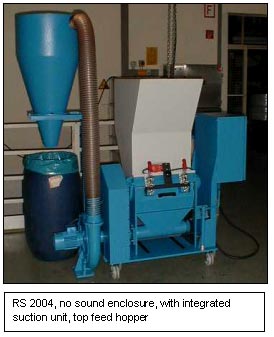 |
Getecha's line of RS 2000 and RS 3000 Series of granulators serve many different application needs due to the flexibility of the build design. These granulators incorporate a modular design of various integral components that can be arranged on standard base designs to meet a variety of application demands, the modularized components include:
Hoppers
Cutting chambers
Rotors
Infeed systems
Evacuation systems
RS 2000 Series Design Features:
Simple Operation
Large, labeled push buttons
Indicator lamps for operational status
Ergonomic design
No-tool clean-out procedures
Pre-Adjustable, off rotor blade setting fixtures as standard
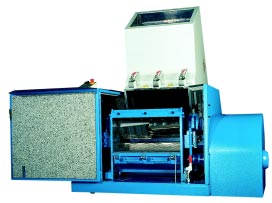 |
Easy to Clean FMC -15 Min.
Hopper and material container easy to open
Quick release clamps - no tools required
Good accessibility to all components
Too free screen removal
High productivity
Continuous throughputs up to 700 lbs./hr
Blade adjustment outside of granulator
Quick to clean
Easy maintenance
Constant cutting circle
Tangential feeding with scissor cutting
|
Developed from practical plastics
industry experience
Modular design
Integrated sound insulation
Flexible variation of components
Variable rotor designs for application requirements
Full line of supporting equipment available
Versatile use
Segmented rotors for various applications
Excellent feeding characteristics
Optimal distribution of cutting forces, even for thicker walled materials
|
 |
SOLUTIONS TO MEET YOUR NEEDS!
Sample installations:
GRANULATION OF SKELETON SHEET
Duty assigned:
Granulating of skeleton sheet after an Illig-line at a maximum construction height of 34 inches.
- Material PP
- Width of sheet up to 28", thickness of sheet max. 1.5 mm
- Stroke 16 inches
- Throughput up to 450 lb/h with a 6 mm screen
| Granulator:
The granulator is RS 2000 Series w/ 10" rotor diameter.
Technical data:
- Feeding width up to 36 inches
- Cutting circle 10 inches
- Drive capacity 20 HP
- Smooth feeding rollers with frequency converter, Hand-hydraulics for opening of the feeding mechanism
|
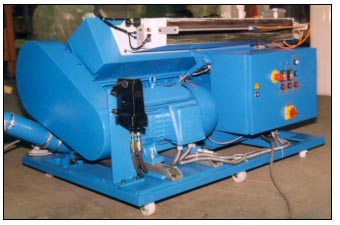 |
Feeding control:
A control jaw could not be inserted as a result of tight space. Two light barriers transmit a signal to the frequency converter when the sheet is too tightly stretched. The feeding process is then switched off.

GRANULATION OF MULTIPLE LAMINATE STRIPS AT DIFFERENT THICKNESSES
Duties assigned:
- Granulating of the marginal strip in the manufacture of laminated floor
- Material: PVC with glass or polyester fibrous web
- B = 50 mm, 0.8 - 4.5 mm strong
- Line speed: 75 ft/min
- Throughput: up to 425 lb/h at 20 mm square holing (coarse crushing)
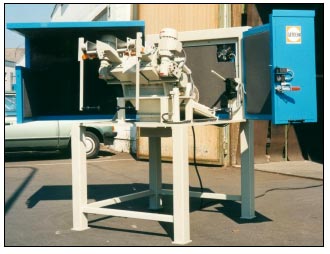 |
Special:
Should the thickness of the marginal strips be different, then the thicker marginal strip may press the feeding roller apart in such a way that the thinner marginal strip can no longer be clamped by the roller and will slide out of the infeed mechanism.
To ensure proper operation, it is therefore reasonable to apply one more infeed mechanism. Both infeed devices have a drive-motor and are therefore independent in their speed. The loops of the marginal strips can thereby be compensated in such a way that approximately equal infeed forces brought to bear on both marginal strips.
The fibrous webs tend to get fluffy. Special design on the front sides of the infeed rollers
Set-up of the granulator on a platform, downward drop of coarsely crushed material
|
|
System design:
RS 2004 with two infeed devices (width 70 mm)
Drive capacity 10 HP
Blade made of HSS (64 HRC) for the cutting of the fibrous webs
Speed control of the infeed mechanism:
Potentiometers are mounted on the centre-point of the rotary axis of the control jaw. Angular changes on the control jaw convert the potentiometer/frequency converter to an Off-Set of the infeed speed. By this means, an automatic adjustment to the production machine is realised.
|
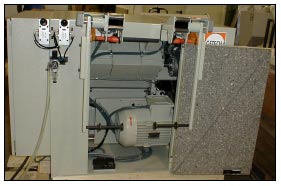 |

GRANULATION OF LONG PROFILES
Duties assigned:
Granulating of profiles with the dimensions 5" X 3" at varying lengths to 16 feet
Moderate throughput capacity
Getecha-solution:
RS 2533 (modified RS 2004), cutting circle Æ 250 mm, 300 mm width of blade
High-type design with bypass hopper
10 HP
Primary hopper infeed for cut-off trim scrap
|
The size of the bypass hopper must be adapted to the cutting circle and the width of the granulator:
Width of the bypass hopper < 80 % of the cutting width radius
The height and the angle of the bypass hopper must be designed in such a way that the profile and the opposite side do not rise up!
Granulator painted per customer specs.
|
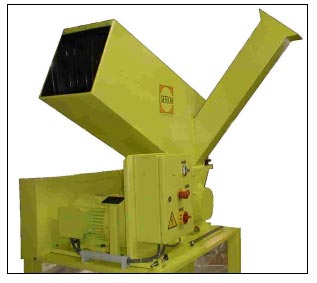 |

Technical specifications:
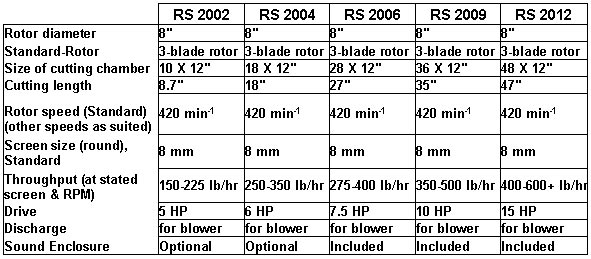
Drawings of Getecha RS 2000 Series granulators:
RS 2000 Series Granulator with sound enclosure and integrated blower
RS 2004 Granulator with dual edge trim infeed
RS 2000 Series for end of sheet line
TEST PRODUCT REVIEWS RS 2000 Series Tested Products:
Part #1: Tested on RS 2004
Piping connector, round
Glass filled nylon or POM
Diameter: 5"
Depth: 1 3/8"
Wall thickness: ½"
|
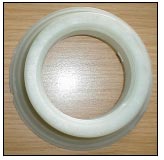 |
Part #2: Tested on RS 2004
Small Trays
Length: 8.25"
Width: 6"
Depth: A: 1.25" B: 2.25" C: 3"
Wall thickness: thin gauge, 1/16"
|
 |
Part #3: Tested on RS 2004
Round piping pieces/fittings/joiners
Diameter: 7.5"
Wall thickness: 9/16"
RS 2004: The unit handled the parts, these items represent the upper limits of material and wall thickness for the standard unit.
|
 |
Part #4: Tested on RS 2004
White Bottle
Length: 12"
Diameter: 4.5"
Wall thickness: thin walled, but shaped to reinforce strength
|
 |
RS 2004: The unit showed no problems in granulating the indicated part. Part can also be run in smaller GRS 300 X 4
Part #5: Tested on RS 2004
Green Automotive Parts
Glass Filled Nylon
Length: 13"
Width: 3"
Depth: 2.5"
Wall thickness: ½" to 5/8" max.
RS 2004: No problems. Part can also
be run in smaller GRS 300
|
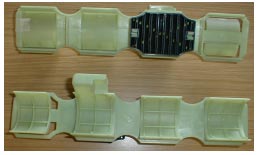 |
Part #6: Tested on RS 2004
Automotive Motor Cover
Length: 18"
Width: 9"
Depth: 4.5", when sitting flat and allowing for the curved nature of part
Wall thickness: ½"
Material: 30% GF Nylon
|
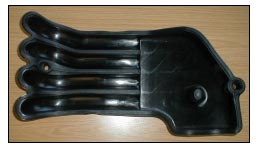 |
RS 2004: handled the part, but feeding of this part needs to be metered.
Part #7: Tested on RS 2004
Fuse Box Face Assembly
Length: 14"
Width: 11"
Depth: 9"
Wall thickness: 7/16"
|
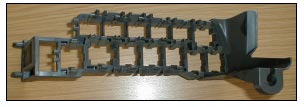 |
RS 2004: No problem, can be batch fed in large quantities. Part can also be run in smaller GRS 300
Part #8: Tested in RS 2004 with bypass hopper
Automotive Fascia, broken into two pieces for photographing
Length: 50"
Width: 6"
Depth: 2.75"
Wall thickness: 1/16 to 3/16"
Material: ABS
RS 2004: No problems, needs bypass hopper.
|
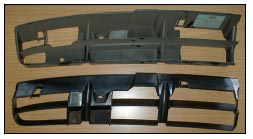 |
Part #9: Tested in RS 2004
Long Handle
Material: Nylon 66 w/ 30% glass fill
Length: 15"
Width: 3.25"
Depth:
Wall thickness: ½"+
|
 |
RS 2004: No problem. The piece can also be run in a smaller GRS 300.
Part #10: Tested in RS 2004
Flexible air flow hose blow molded
Material: Buttle
Length: 17"
Width: 3.25"
Wall thickness: difficult section, very thick walled top or tail
RS 2004 notes: The unit granulated the part, but due to the material, manufacturing process and required throughput, typically a RS 3000 series unit would be recommended.
|
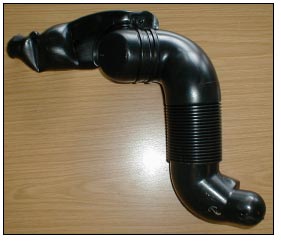 |
Part #11: Tested in RS 2004
Automotive assembly part (electrical)
Length: 4.5"
Width: 5"
Wall thickness: 1"+
Material: Highly glass filled Nylon
The RS 2004 granulated the part at peak of ability. Suggest a larger unit (ie. 3004) unless the unit will granulate mostly sprues and only occasional reject parts. The RS 2004 unit is not suitable for batch feeding of this part.
|
 |
Part #12: Tested in RS 2004
Plumbing fixture
Length: 4.5"
Width: 4.5"
Wall thickness: 0.375""+
Diameter: 1.75"
Material: Rigid PVC
RS 2004 with a 7.5 HP motor is successful. Requires metering of the feeding process.
|
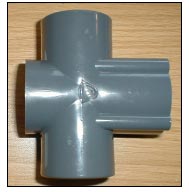 |
Part #13: Tested in RS 2004
PVC Plumbing Parts
Length: 1 7/8"
Width/Diameter: 2.5"
Wall thickness: 3/16" with beefiest part up to 5/16"
|
 |
RS 2004: No problems encountered, should could also be granulated on a GRS 300.
Part #14: Tested in RS 2004
Profile, shallow u-shaped cap/cover
Material: flexible PVC
Length: 7.5" to several feet
Width: 2"
Depth: 5/8"
Wall thickness: 3/16"
|
 |
RS 2004: No problem encountered with the short pieces tested. Special bypass hopper required for feeding in long lengths.
|



